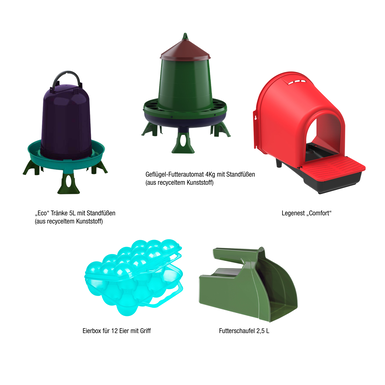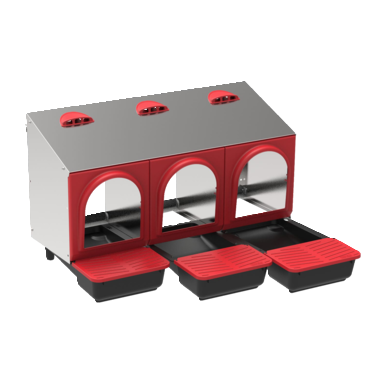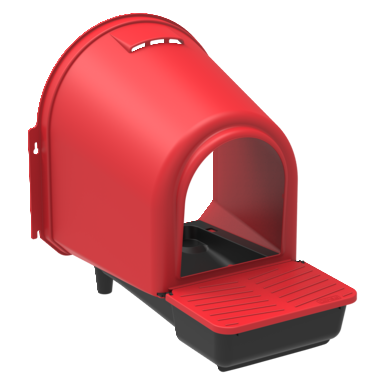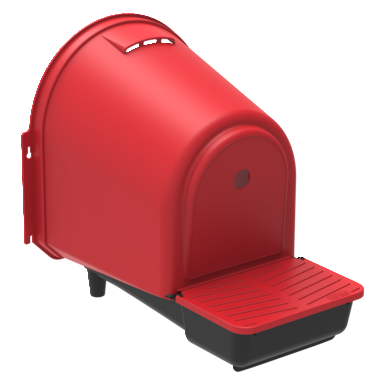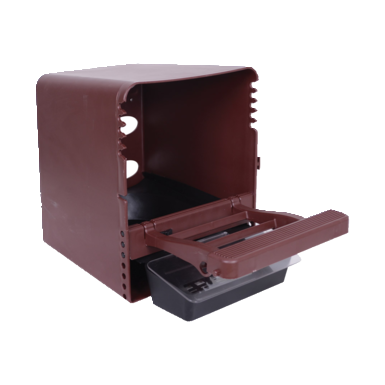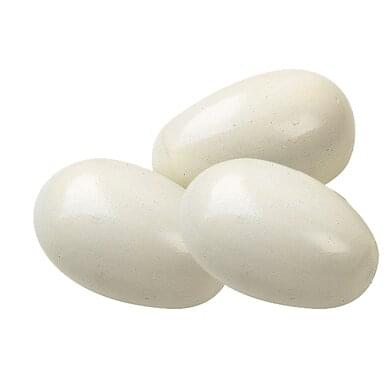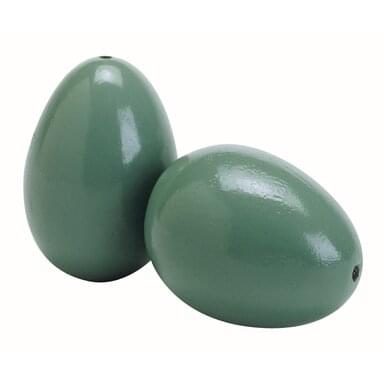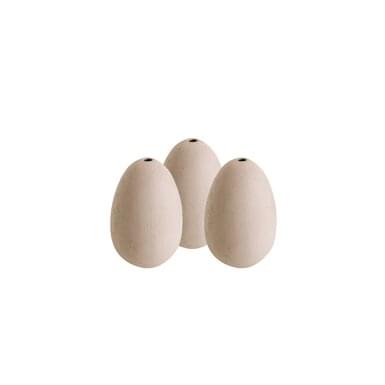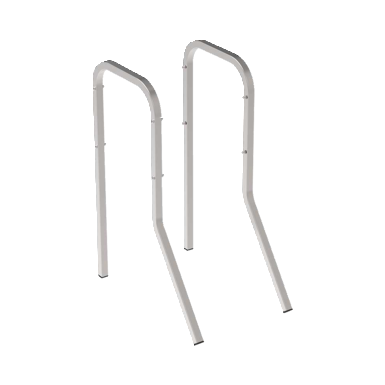Laying nests
- For more comfort for chicken and chicken keeper
- The ideal gadget for your chicken coop
- Different nest models for your individual needs
Plastic laying nest "MyCozyNest" for chickens
- Undisturbed laying place, as darkened and ventilated
- Easy egg removal due to good handling
- Easy mounting due to fastening to the wall
- Good hygiene due to easy cleaning
Starterset für Legehennen
- Egg box for 12 eggs: Safe, tidy storage for fresh eggs - With a practical handle for easy carrying - Modern design makes it a stylish, functional accessory for your hen house
- Feed scoop: Lightweight, handy feed scoop with a generous capacity of 2.5kg - ideal for effortlessly filling feeders or drinking troughs
- Laying nest: Comfortable, protected nest, provides the ideal environment for laying fresh eggs - With generous space - Constructed from robust materials for long-lasting, sustainable use
- Chicken drinker: Reliable water source with a capacity of 5 litres - Made from 100% recycled plastic - With sturdy feet for secure footing and cleanliness
Legenest PLATINUM 2 Abteile
- Flexible placement in the chicken coop
- Each compartment has a nest tray made of 100% antiseptic plastic for 8 to 12 eggs
- Inclined base of the tray - the eggs are protected under the cover
- Uncomplicated removal of the eggs
Legenest PLATINUM 3 Abteile
- Flexible placement in the chicken coop
- Each compartment has a nest tray made of 100% antiseptic plastic for 8 to 12 eggs
- Inclined base of the tray - the eggs are protected under the cover
- Uncomplicated removal of the eggs
Laying nest with drip trayest
- Clean and simple solution for your chicken coop
- Roll-off nest - Integrated egg tray for 8 to 12 eggs for more comfort for chicken and chicken keeper
- Kit for uncomplicated self-assembly & quick and easy wall mounting
- Ventilated and darkened laying nest for comfortable egg laying
Laying nest with collecting tray, ID, RECYCELT, black
- Clean and simple solution for your chicken coop
- Roll-off nest - integrated egg tray for 8 to 12 eggs for more comfort for chicken and chicken keeper
- Kit for uncomplicated self-assembly & quick and easy wall mounting
- Ventilated and darkened laying nest for comfortable egg laying
Laying nest | galvanized steel
- Fully galvanized
- Weather resistant and robust
- Hygienic thanks to sloped bottom
- Outdoor construction: you save space in the henhouse and can conveniently collect laid eggs without having to enter the henhouse
- Clean and simple solution for your chicken coop
- Roll-off nest - Integrated collecting tray for 8 to 12 eggs - More comfort for chicken and chicken keeper
- Kit for uncomplicated self-assembly & quick and easy wall mounting
Plastic Laying Nest CHICKBOX | brown
- Particularly hygienic, therefore reduction of diseases and bacteria
- Smooth high quality ABS plastic surface which is easy to clean
- Clean removal of the eggs due to additional protection
- Suitable for 4 to 5 chickens
Beine Legenester PLATINUM
- Innovative solution for increased hygiene
- No drilling or wall mounting required
- Flexibly customisable
- Quick and easy installation
Laying nests for chickens - comfort for owner and chicken
It's that time again, the laying hens are starting to lay their first eggs. In order to have a species-appropriate chicken husbandry right from the start, get your hens used to laying the eggs in the laying nest. There are different laying nests with different quality. Before you choose a laying nest, you should find out which nest meets your requirements. In the following article you will learn what you need to consider when laying nests.
Why do chickens need a laying nest?
As soon as people learn about keeping chickens, the word laying nest often comes up. But what is it anyway and is it necessary?
A laying nest is part of the basic equipment of the chicken house, whether professional laying hen keeping or hobby keeping. As the name suggests, the laying nest creates an undisturbed place for the hens to lay their eggs. The nest also ensures hygienic removal of the eggs and protects them from breakage. Chickens are instinct animals and their instinct is to hide the eggs. To make this possible, a laying nest is necessary. The Animal Welfare Act also stipulates that there must be at least one laying nest for every five hens. However, make sure that your hens have a separate place to sleep and do not sleep in the laying nest.
How do you get chickens used to laying nests?
Nest eggs are an important accessory when keeping poultry. They are a help in getting the hens used to the laying nest. There should be two to three per nest. Chickens prefer to lay their eggs in a nest where there are already some inside. There are different types of nest eggs. The colour and size is irrelevant. What is important to consider is the material of the nest egg. You can choose between wood and ceramic.
The different types of laying nests at a glance
When it comes to laying nests, a distinction is made on the one hand between the material (plastic, wood or metal) and the design. The first question would be whether you would like to have a laying nest with a collection tray or not.
Advantages of laying nests with egg collecting tray (roll-off nest)
Roll-off nests would certainly be the simpler option for farmers or hobby keepers. As the name suggests, the eggs roll into a collection container or tray. This means that no time-consuming search is necessary and the hens are not irritated or stressed. Egg collection is thus made easier. An essential advantage of a roll-off nest would be that the eggs are protected from dirt and damage.
Then decide whether you want a single, multiple or group nest.
Generally, a multiple or group nest is recommended, as hens feel more comfortable in a community, which increases the laying performance. However, you should also have individual nests. Some hens prefer their peace and quiet and like to withdraw.
What materials can nests be made of?
A metal laying nest is ideal for outdoor use as it is perfectly protected from the weather. The bottom of the laying nest is made of a grid and allows for hygienic storage of the eggs, which can be removed through a drawer.
Plastic
Plastic laying nests are ideal for chicken keepers who are looking for a simple and uncomplicated nest. It is particularly easy to clean and much lighter in weight than a wooden nest. Especially important with regard to poultry keeping, the risk of injury is low due to the rounded corners.
Which laying nest is the right one?
Depending on the requirements, it must be decided whether the nest should be placed or hung up. The type of nest is also important. There are single nests, multiple nests (several nests above or next to each other) and group nests (one nest for several hens).
Multiple and group nests can increase the hens' well-being, which has a positive effect on laying performance.
What is important in nest hygiene?
It is not enough to build the nest and wait. The right equipment is important here.
For litter, you have a choice of straw, hay or hemp shavings. It is important that it is dry and soft so that the hens feel comfortable and the eggs are protected. Don't forget to change the litter regularly to ensure good hygiene and protection from parasites such as mites. You can counteract this with regular cleaning and diatomaceous earth.
How big should a laying nest be?
There is no general answer to this question. You have to consider the different breeds and houses.
- How many chickens are kept?
- What breed are they?
- How big is the coop?
How many laying nests do I need?
The number of laying nests varies based on the breed and age of the chickens.
A general rule of thumb would be: one nest is enough for about three to five hens. If you have enough space in your henhouse, allocate one nest to three hens.
What size should the nest be?
The choice of size depends on the breed of hens kept. Accordingly, there is a wide range to choose from. If we assume that medium sized chickens are kept, a 30 x 30 cm chicken nest is sufficient.
It isimportant not to mix up the inside and outside dimensions. The inner dimensions can be used to see whether the chicken fits comfortably into the nest. The outer dimensions determine whether the nest fits into the hen house.
At what height should the laying nest be placed?
Important Place the laying nests so that the chickens still have enough space at the bottom. Especially in small coops.
Chickens prefer higher positions, so the laying nests should be placed at the same height and next to each other. Ideally, the nests should be placed at a height of 80 cm. This leaves enough space to the floor.
Why does the chicken not lay eggs in the laying nest?
Chickens are routine animals, once they get used to laying their eggs on the floor, it becomes difficult to change this. There are several things you can try to change this behaviour:
- sufficient laying nests
- Clean nesting place
- Sufficient roosting space
- Use of nest eggs
- easy access to the laying nests
Conclusion
Laying nests belong to the basic equipment of every species-appropriate keeping of chickens. It doesn't matter whether they are used by hobby keepers or farmers. They offer the chickens and the keeper of the animals an easy and comfortable option. In the Horizont online shop you will find a wide selection of laying nests for your individual use.



